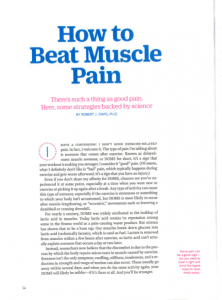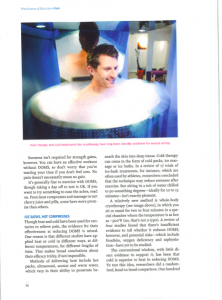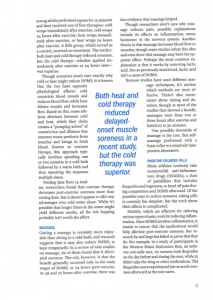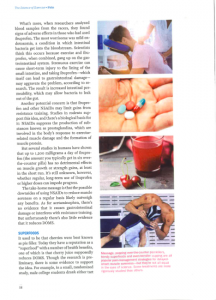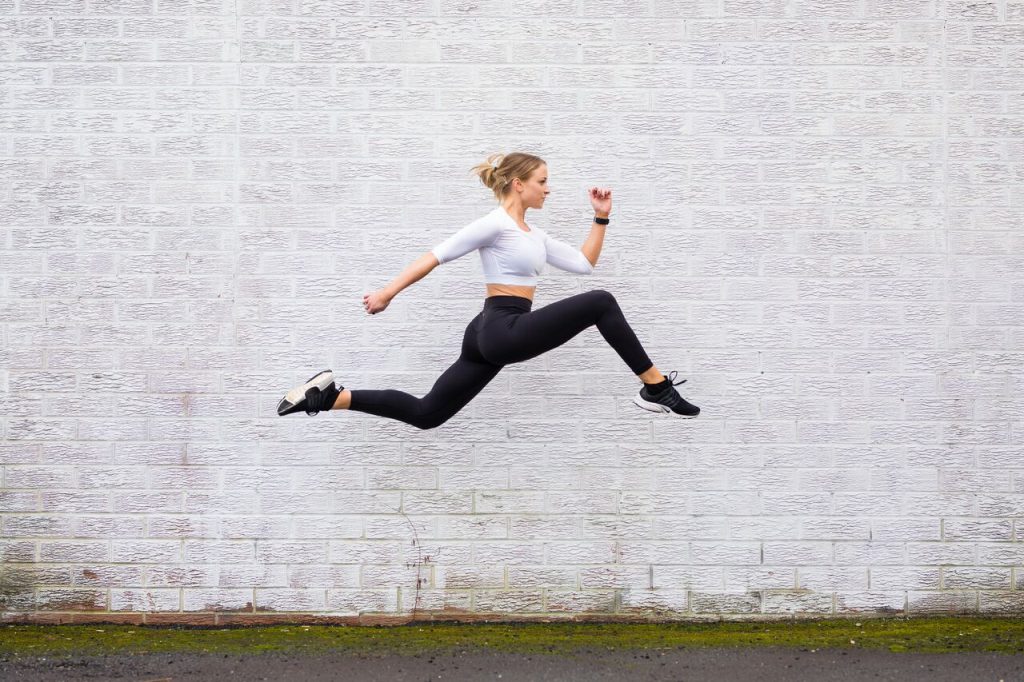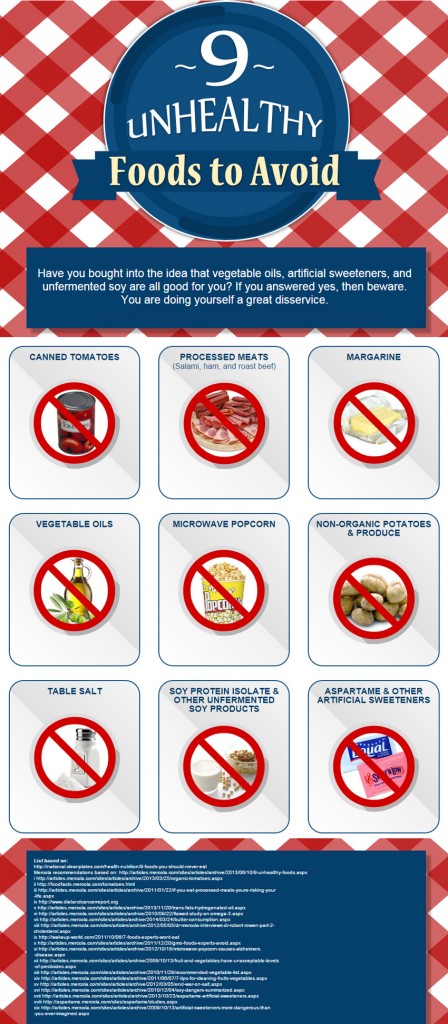9 Common Myths About Exercise
Exercise advice can be misleading. Here are nine familiar fitness directives that may be unnecessary or even counterproductive.
Stretch beforehand to prevent injuries.
Many of us learned in gym class or little league that static stretching, such as reaching for your toes and holding the stretch, before activity can prevent injury. But research has generally failed to support the idea. What’s more, pre-exercise static stretches may even do harm by impairing performance. One possible reason is that a looser muscle acts like an overstretched slingshot, generating less force than one that’s taut. Another theory is that stretching “cold” muscles damages them.A better approach is to warm up and then do dynamic stretches, such as arm or leg swings, which involve movement. Unlike static stretching, dynamic stretching primes muscles for action and may improve performance. In a study of young and middle-aged men, for example, vertical jump heights increased after dynamic stretching, while they declined after static stretching.Save static stretching for after exercise, when your muscles are warm. Hold each stretch for 20 to 30 seconds. You should feel tightness or slight discomfort, but not pain.
Exercise on an empty stomach to burn more fat.
The rationale behind doing aerobic exercise on an empty stomach, a practice known as “fasted cardio,” is that when carbohydrate stores in the body are depleted, you burn mainly fat. In addition, when insulin levels are low, which is the case when you fast, you burn more fat.Indeed there’s some evidence that fasted cardio may boost fat burning—but only fleetingly. Over the course of days or weeks (which is what counts), research shows that fasted cardio doesn’t offer any advantages. In a four-week trial that randomly assigned young women to either fast or drink a 250-calorie shake before their aerobic workouts, while otherwise eating a low-calorie diet, both groups lost the same amount of fat and weight.Indeed there’s some evidence that fasted cardio may boost fat burning—but only fleetingly. Over the course of days or weeks (which is what counts), research shows that fasted cardio doesn’t offer any advantages. In a four-week trial that randomly assigned young women to either fast or drink a 250-calorie shake before their aerobic workouts, while otherwise eating a low-calorie diet, both groups lost the same amount of fat and weight.
Monitor your heart rate during exercise.
To measure exercise intensity, some programs have people wear heart-rate monitors and stay within a particular zone. Many gyms and cardio machines display charts showing what your target heart rate should be.The problem is that these targets are dependent upon your maximum heart rate (MHR), which is notoriously hard to measure on your own. The conventional way is to subtract your age from 220. But that formula is too simplistic and often yields flawed results, especially in older people. Other formulas have been shown to be lacking as well. If your MHR estimate is off, your target zone will be too high or too low.While people with medical conditions may require a heart-rate monitor during activity, most of us can use a simpler method to gauge intensity: a scale from 1 to 10 that measures how hard you feel your body is working overall. A 5 or 6 indicates moderate intensity, and a 7 or higher means vigorous activity.Perhaps the easiest method is the talk test. If you can talk and sing during your activity without becoming breathless, the intensity level is low. If you can talk but not sing, the intensity is moderate. And if you can say only a few words before having to catch your breath, you’re doing vigorous exercise.
Hold weights when you walk.
Carrying small dumbbells or wearing wrist weights seems, in theory, like a good way to boost the intensity of your walks while also working your upper body. In fact, adding weight does burn more calories. But there’s a problem. The light weights that people often use for walking typically burn too few extra calories to really matter. And heavier weights necessary for meaningful calorie burning may alter your natural arm swing and increase the risk of injuries.A better option may be to walk with poles. The practice, sometimes called Nordic walking or exerstriding, originated in Finland as an off-season training method for cross-country skiers. Research suggests that pole walking works upper body and abdominal muscles, allows you to walk faster and burns more calories than regular walking—all without making you feel as though you’re working harder. In addition, unlike weights, which may put stress on your joints, pole walking takes pressure off your knees, hips and lower back.
Buy running shoes based on your foot type.
Running shoes come in several categories, each designed for a different foot type. Stability shoes are for runners whose feet roll inward excessively or “overpronate” when they land, while motion control shoes are intended for those who have flat feet and are severe overpronators. Neutral shoes are designed for runners with high arches who don’t overpronate or who underpronateFor years it’s been widely assumed that overpronation leads to injuries and that using the right shoe can reduce the risk. But research has called these beliefs into question. In a study of more than 900 novice runners, all were instructed to use the same model of neutral shoes regardless of their foot type. Surprisingly, the runners with overpronated feet experienced fewer injuries than those with neutral feet, even though the overpronators were using the “wrong” shoe.This study comes on the heels of other research showing that assigning shoes based on foot type does not reduce injury risk. While a stability or motion control shoe may be the best choice for some people, your best bet is likely a neutral shoe that’s comfortable.
Drink even when you’re not thirsty.
Conventional wisdom (much of it influenced by makers of sports beverages) asserts that you should “stay ahead of your thirst” before, during and after exercise to avoid dehydration. But studies show that for most people, thirst is a reliable indicator of when you need more fluid, even during exercise.Research suggests that dehydration isn’t always the threat that it’s portrayed to be. Contrary to popular belief, it’s generally not a cause of exercise-related muscle cramps or heat illness. And studies involving competitive cyclists have found that mild dehydration doesn’t impair exercise performance. What’s more, drinking only when thirsty results in better performance than does chugging constantly.Though you want to make sure to consume enough water, especially if you’re older or exercising in the heat, a bigger problem than dehydration may be drinking too much during exercise. If you take in so much fluid that your body can’t get rid of the excess, sodium levels can become dangerously low. The resulting condition, known as hyponatremia or water intoxication, is potentially fatal. To head it off, simply drink when you’re thirsty.
Check the color of your pee to see whether you’re dehydrated.
You’ve likely heard that urine ideally should be pale yellow and that the darker it is, the more you’re dehydrated. It turns out the science behind such guidance isn’t so clear. In a review of the evidence, researchers debunked the notion that urine color is an accurate marker of hydration. Part of the problem is that some foods (such as beets and carrots) can affect the color of urine, as can certain vitamins. Ditto for some medications and dietary supplements. What’s more, striving for pale pee could cause some people to overhydrate themselves during exercise and develop hyponatremia.If you’re concerned that your workout routine is leaving you dehydrated, try weighing yourself without clothes before and after exercise. If you lose up to a few pounds, you’re likely okay. If you lose more than that, you may want to increase your fluid intake. If, on the other hand, you gain weight, you may be drinking too much.
Eat afterward to refuel.
While you’ve probably heard that downing protein within an hour or so after strength training is necessary to maximize gains, the research on this is mixed. The science is even less conclusive on whether eating protein after aerobic exercise is beneficial.Consuming carbohydrates after exercise may help endurance athletes, especially if they have another training session later in the day. Some research suggests that chocolate milk is an ideal recovery food for such athletes because of its ratio of carbohydrates to protein. But for the rest of us who do a typical exercise routine of walking or running for 30 to 60 minutes, there’s generally no need to refuel with chocolate milk or anything else. In fact, if you’re watching your weight, adding calories after your workouts—without reducing them sufficiently elsewhere in your diet—could undermine your efforts.
Avoid sex before competition.
Abstinence from sex has long been considered essential for success in sports. As Rocky Balboa’s trainer put it in the movie Rocky, “women weaken legs.” But research has yielded little support for the belief. One study, which involved former male athletes, measured grip strength the morning after they’d had sex with their wives and then repeated the test after the men had abstained for at least six days. There were no differences in test results.Overall, the research suggests that sex before physical activity doesn’t have negative effects as long as there’s a lag of at least two hours and the sexual activity doesn’t also involve alcohol, drugs or sleep loss. In fact, it’s possible that sex may even enhance athletic performance by helping people relax.It’s unknown whether women are affected differently than men. The impact likely varies from person to person, so if you’re wondering how pre-game sex affects your golf score or your 5K race time, you‘ll need to do your own experiment and see for yourself.Adapted from TIME Health Magazine at http://time.com/4779651/exercise-myths-heart-rate/?xid=homepage
We hope you all enjoyed this amazing article!
Caroline Kolowich


